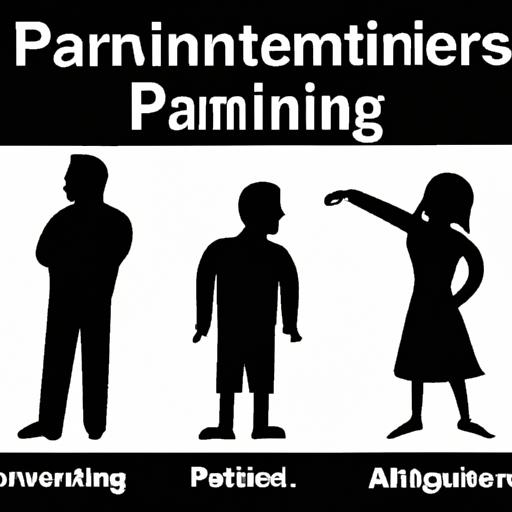What Are the Four Major Parenting Styles?

Parenting plays a crucial role in shaping a child’s development and future. As parents, we often find ourselves wondering if we are doing it right or if there is a better way to raise our children. Understanding the different parenting styles can provide valuable insights into our approach and help us navigate this incredible journey with confidence.
In this article, we will explore the four major parenting styles and delve into their impact on children’s development. By understanding these styles, you will gain a better understanding of your own parenting approach and discover practical tips to enhance your parenting skills.
The Importance of Parenting Styles in Child Development

Parenting styles are not mere labels; they are influential frameworks that shape a child’s behavior, emotional well-being, and overall development. The way we interact with our children, set boundaries, and communicate with them lays the foundation for their self-esteem, social skills, and ability to handle challenges.
Overview of the Four Major Parenting Styles

-
Authoritative Parenting Style: This style emphasizes a balance between setting clear boundaries and fostering independence. Authoritative parents are nurturing, responsive, and open to communication. They provide guidance while allowing their children to make age-appropriate decisions, building their confidence and autonomy.
-
Authoritarian Parenting Style: Characterized by strict rules and high expectations, authoritarian parents often rely on discipline and control. While their intentions may be well-meaning, this parenting style can stifle a child’s creativity and self-expression, potentially leading to low self-esteem and difficulties in decision-making.
-
Permissive Parenting Style: Permissive parents are lenient and nurturing, often avoiding confrontation and setting few boundaries. While this parenting style may create a warm and accepting environment, it can also lead to children struggling with self-discipline, respecting authority, and adapting to rules outside the home.
-
Uninvolved Parenting Style: This style is characterized by a lack of emotional involvement and minimal guidance. Uninvolved parents may be preoccupied with their own lives or neglectful, leading to feelings of abandonment and insecurity in children.
Understanding these four major parenting styles is the first step towards becoming a more effective and intentional parent. In the following sections, we will explore each style in more detail and provide practical tips on how to implement positive aspects while avoiding potential pitfalls.
Stay tuned to discover which parenting style resonates with you and find inspiration to nurture your child’s potential while fostering a loving and supportive environment. Together, let’s embark on a journey of growth and understanding as we uncover the secrets of effective parenting.
Next Section: Authoritative Parenting Style
Authoritative Parenting Style

Definition and Characteristics
The authoritative parenting style is often regarded as a balanced and effective approach to raising children. It combines warmth, guidance, and clear expectations, creating an environment that fosters healthy development. Authoritative parents are responsive and nurturing, while also setting reasonable boundaries and expectations for their children.
Key characteristics of authoritative parenting include:
-
Open Communication: Authoritative parents prioritize open and honest communication with their children. They actively listen, validate their feelings, and encourage dialogue, fostering a strong parent-child relationship built on trust and respect.
-
Clear Expectations: While authoritative parents set rules and expectations, they also provide clear explanations and reasoning behind them. This approach allows children to understand the purpose behind rules and develop a sense of responsibility.
-
Flexibility: Unlike authoritarian parents who enforce strict rules without room for negotiation, authoritative parents are flexible and willing to adapt to their child’s individual needs and developmental stage. They encourage independence and decision-making while offering guidance and support.
Positive Effects on Children’s Development
Research shows that children raised in authoritative households tend to experience positive outcomes in various aspects of their lives. Some benefits of authoritative parenting include:
-
Self-esteem and Confidence: By providing a nurturing and supportive environment, authoritative parents promote healthy self-esteem and confidence in their children. They acknowledge their child’s achievements while also encouraging them to learn from their mistakes.
-
Social Competence: Children raised with authoritative parenting tend to develop strong social skills. The open communication and guidance offered by authoritative parents teach children how to express themselves, resolve conflicts, and build positive relationships with others.
-
Academic Success: Authoritative parenting emphasizes the importance of education and instills a love for learning. The clear expectations and support provided by authoritative parents contribute to a child’s academic success and motivation.
Examples and Practical Tips for Implementing Authoritative Parenting
To implement authoritative parenting effectively, consider the following tips:
-
Set Reasonable Boundaries: Establish clear rules and expectations that align with your child’s age and developmental stage. Communicate these boundaries calmly and provide explanations to help your child understand why they are in place.
-
Foster Independence: Encourage your child to make age-appropriate decisions and take responsibility for their actions. Offer guidance and support, but allow them to learn from their experiences and develop autonomy.
-
Practice Active Listening: Take the time to actively listen to your child’s thoughts, concerns, and emotions. Validate their feelings and provide support, creating a safe space for open communication.
-
Lead by Example: Be a role model for your child by demonstrating the behavior and values you wish to instill in them. Show empathy, respect, and positive problem-solving skills in your interactions with others.
Remember, authoritative parenting is about finding the right balance between setting boundaries and fostering independence. By implementing these strategies, you can create a nurturing and supportive environment that promotes your child’s overall well-being and development.
Next Section: Authoritarian Parenting Style
Authoritarian Parenting Style
Definition and Characteristics
The authoritarian parenting style is characterized by strict rules, high expectations, and a strong emphasis on discipline. Authoritarian parents tend to have a “my way or the highway” approach, where obedience and compliance are valued above all else. They often utilize punishment and control as means of enforcing their rules, believing that it will shape their child’s behavior.
Negative Effects on Children’s Development
While authoritarian parenting may seem effective in maintaining order and discipline, it can have detrimental effects on a child’s development. Children raised in authoritarian households may struggle with low self-esteem, lack of autonomy, and difficulties in decision-making. The constant focus on obedience can hinder their ability to think critically and problem-solve, potentially impacting their academic and social success.
Examples and Practical Tips for Avoiding Authoritarian Parenting
If you find yourself leaning towards an authoritarian parenting style, it’s essential to recognize the negative impact it can have on your child’s well-being. Here are some examples and practical tips to help you avoid falling into the authoritarian trap:
-
Open Communication: Foster an environment where your child feels safe expressing their thoughts and emotions. Encourage open dialogue, active listening, and empathy. This will help build trust and strengthen your relationship.
-
Negotiation and Compromise: Instead of imposing strict rules without question, involve your child in decision-making processes. Consider their opinions and negotiate whenever possible. This will help them develop critical thinking skills and a sense of ownership over their choices.
-
Positive Reinforcement: Focus on positive reinforcement rather than solely relying on punishment. Praise and acknowledge your child’s efforts and achievements, fostering a sense of intrinsic motivation and self-worth.
-
Setting Reasonable Expectations: Establish clear expectations and guidelines for your child, but ensure they are age-appropriate and realistic. Avoid setting unattainable standards that may discourage them and lead to feelings of failure.
-
Teaching Responsibility: Encourage your child to take responsibility for their actions and consequences. Help them understand the impact of their choices and guide them towards making responsible decisions.
By implementing these strategies, you can gradually shift away from an authoritarian approach and create a nurturing and supportive environment that promotes your child’s growth and development.
Next Section: Permissive Parenting Style
Permissive Parenting Style
Definition and Characteristics
The permissive parenting style is characterized by leniency, low demands, and a lack of structure. Permissive parents often prioritize their children’s happiness and avoid confrontation by being overly indulgent and permissive. They may have difficulty setting clear boundaries, enforcing rules, and disciplining their children effectively.
Negative Effects on Children’s Development
While permissive parenting may create a warm and accepting environment, it can have detrimental effects on a child’s development. Without clear boundaries and consistent discipline, children may struggle with self-control, decision-making, and respecting authority figures. They may also have difficulties adjusting to rules outside the home and may exhibit entitlement or impulsive behaviors.
Examples and Practical Tips for Setting Boundaries and Rules
-
Establish clear expectations: Clearly communicate your expectations to your child, whether it’s about behavior, chores, or academic performance. Be specific and consistent in what you expect from them.
-
Set age-appropriate boundaries: Understand your child’s developmental stage and set appropriate boundaries accordingly. Age-appropriate rules and limits help children understand their responsibilities and develop self-discipline.
-
Enforce consequences: It is essential to follow through with consequences when your child crosses a boundary or breaks a rule. This helps them understand the importance of accountability and responsibility.
-
Encourage open communication: Foster an environment where your child feels comfortable discussing their feelings and concerns. Encourage them to express themselves, and listen attentively without judgment.
-
Be a role model: Lead by example and demonstrate the behavior you expect from your child. Show them how to handle conflicts, make decisions, and take responsibility for their actions.
Remember, finding the right balance between being nurturing and setting boundaries is crucial for effective parenting. By implementing these practical tips, you can gradually transition from a permissive parenting style to a more balanced and authoritative approach that promotes your child’s healthy development.
Next Section: Uninvolved Parenting Style
Uninvolved Parenting Style
Definition and Characteristics
The uninvolved parenting style, also known as neglectful parenting, is characterized by a lack of emotional involvement, minimal guidance, and limited responsiveness from parents. In this style, parents may be disengaged, preoccupied with their own lives, or neglectful of their child’s needs. They may provide basic necessities but fail to offer emotional support, attention, or guidance.
Negative Effects on Children’s Development
Uninvolved parenting can have detrimental effects on a child’s overall development. When children do not receive the emotional connection and guidance they need, they may experience feelings of neglect, insecurity, and low self-esteem. These children often struggle with forming healthy relationships, regulating their emotions, and developing a positive sense of self. They may also exhibit behavioral problems, academic difficulties, and have a higher risk of engaging in risky behaviors.
Examples and Practical Tips for Becoming More Involved in Parenting
If you find yourself leaning towards an uninvolved parenting style, it’s important to take steps to become more actively engaged in your child’s life. Here are some examples and practical tips to help you:
-
Prioritize Quality Time: Dedicate regular time solely for your child, free from distractions. Engage in activities they enjoy, have meaningful conversations, and show genuine interest in their interests and concerns.
-
Express Love and Affection: Regularly express love, warmth, and affection towards your child. Hug them, praise their efforts, and provide positive reinforcement. These small gestures can go a long way in building a strong emotional connection.
-
Communicate Openly: Create an environment where your child feels comfortable expressing their thoughts and emotions. Listen attentively, validate their feelings, and offer guidance and support when needed.
-
Set Boundaries and Expectations: While being involved does not mean being permissive, it is essential to establish clear boundaries and expectations for behavior. Consistently enforce rules and provide age-appropriate structure to help your child feel secure.
-
Seek Support and Resources: If you are struggling with becoming more involved, seek support from other parents, join parenting groups, or consult professionals who can provide guidance and resources tailored to your situation.
Remember, parenting is a journey of growth and learning. By recognizing the negative effects of uninvolved parenting and taking steps to become more actively engaged, you can create a nurturing and supportive environment that promotes your child’s well-being and development.
Next Section: Conclusion
Conclusion
Parenting styles have a profound impact on a child’s development, shaping their personality, values, and overall well-being. By understanding the four major parenting styles, we can make informed decisions about our own approach and create a nurturing environment that fosters growth and resilience in our children.
Throughout this article, we have explored the authoritative, authoritarian, permissive, and uninvolved parenting styles. Each style has its strengths and weaknesses, and it’s important to find a balance that works for our unique family dynamics and our child’s individual needs.
The authoritative parenting style, with its emphasis on setting boundaries while nurturing independence, has been proven to have positive effects on children’s development. By providing guidance and allowing children to make age-appropriate decisions, we can empower them to become confident, responsible individuals.
On the other hand, the authoritarian style, with its strict rules and control, can hinder a child’s ability to express themselves and make decisions. It’s important to avoid an overly authoritarian approach and instead focus on open communication, understanding, and flexibility.
The permissive style, characterized by leniency and few boundaries, can lead to challenges in self-discipline and respecting authority. By setting clear expectations and limits, we can create a supportive environment where our children can thrive.
Lastly, the uninvolved style, where parents are emotionally distant and provide minimal guidance, can leave children feeling neglected and insecure. It’s crucial to be present and involved in our children’s lives, offering love, support, and guidance as they navigate the world.
In conclusion, understanding the four major parenting styles equips us with the knowledge to create a balanced and effective approach to parenting. By adapting our style based on our child’s needs and fostering a loving environment, we can lay the foundation for their future success and well-being.
Thank you for joining me on this journey of exploring parenting styles. Remember, parenting is a continuous learning process, and there is no one-size-fits-all approach. Let’s embrace the joys and challenges of parenthood, always striving to be the best version of ourselves for our children.
Note: This article was written exclusively for tintucvn365.com.





